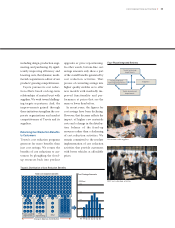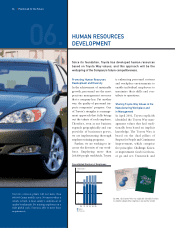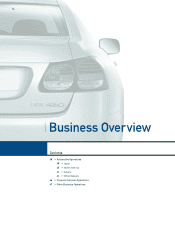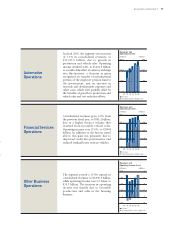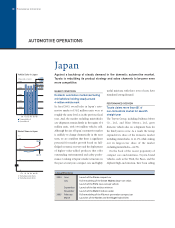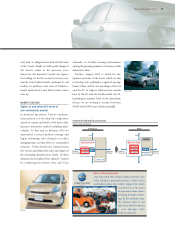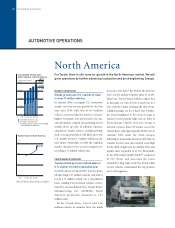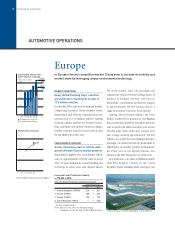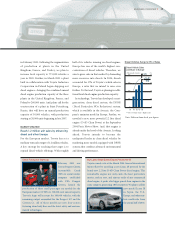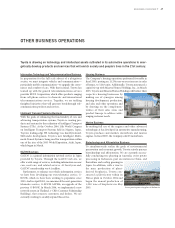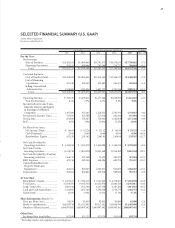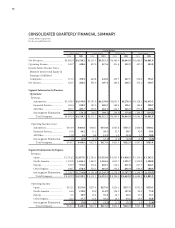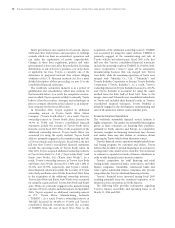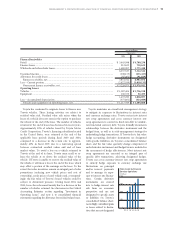Toyota 2005 Annual Report Download - page 45
Download and view the complete annual report
Please find page 45 of the 2005 Toyota annual report below. You can navigate through the pages in the report by either clicking on the pages listed below, or by using the keyword search tool below to find specific information within the annual report.
BUSINESS OVERVIEW >43
in February 2005. Following the augmentation
of production at plants in the United
Kingdom, France, and Turkey, we plan to
increase local capacity to 775,000 vehicles a
year in 2005. Further, in March 2005 a plant
built in collaboration with Toyota Industries
Corporation in Poland began shipping out
diesel engines—bringing the combined annual
diesel engine production capacity of the three
plants in the United Kingdom, France, and
Poland to 260,000 units. And, plans call for the
construction of a plant in Saint Petersburg,
Russia, that will have an annual production
capacity of 50,000 vehicles, with production
starting at 20,000 units beginning in late 2007.
MARKET STRATEGY
Reach 1.2 million unit sales by enhancing
diesel and other lineups
For the European market, Toyota has set a
medium-term sales target of 1.2 million vehicles.
A key strategy for reaching that target is to
expand diesel-vehicle offerings. With roughly
half of its vehicles running on diesel engines,
Europe has one of the world’s highest con-
centrations of diesel vehicles. Therefore, we
aim to grow sales in that market by channeling
more resources into diesels. In 2004, diesels
accounted for 37% of Toyota’s vehicle sales in
Europe, a ratio that we intend to raise even
further. To that end, Toyota is phasing in addi-
tional local diesel engine production capacity.
In technology, Toyota has developed a next-
generation, clean diesel system, the DPNR
(Diesel Particulate NOx Reduction) system,
which is available in the Avensis, the Com-
pany’s mainstay model in Europe. Further, we
unveiled a new, more powerful 2.2 liter diesel
engine (D-4D Clean Power) at the September
2004 Paris Motor Show. And, that engine is
already under the hood of the Avensis. Looking
ahead, Toyota intends to become the
undisputed leader in clean diesel vehicles by
marketing more models equipped with DPNR
systems that combine advanced environmental
and driving performance.
Czech Production Starts Up
February 2005 saw
Toyota Peugeot Citroën
Automobile Czech
(TPCA), a joint venture
company established
with PSA Peugeot
Citroën, launch the
production of three small passenger car models for the
European market. Of TPCA’s 300,000-unit annual capacity,
Toyota’s Aygo will account for 100,000 vehicles, with the
remaining output earmarked for the Peugeot 107 and the
Citroën C1. All of those models are new four-seaters
featuring clean body lines and the latest safety and environ-
mental technologies.
Our Latest Clean Diesel Engine Powers the IS
Toyota caused a stir at the March 2005 Geneva International
Motor Show by unveiling a new Lexus IS powered by the
brand-new 2.2 liter D-4D Clean Power diesel engine. This
remarkable engine not only emits the least particulate
matter, such as soot, and nitrous oxide of any commercial
diesel engine, it packs a far bigger punch than engines in the
same category, generating 180 horsepower. We plan to sell the
new-model Lexus IS
in Japan, the U.S.,
Europe, and other mar-
kets worldwide from
the second half of 2005.
Diesel Vehicles Surge to 37% of Sales
Note: Different from fiscal year figures
200
100
300
400
’01 ’02 ’03 ’04
0
20
10
30
40
0
Diesel Vehicle Sales
and Share in Europe
(Thousands of units) (%)
+14.5%
312
CY
Diesel vehicle share (Right scale)
37%


